12 Underrated Canned Foods You Should Be Eating More Often
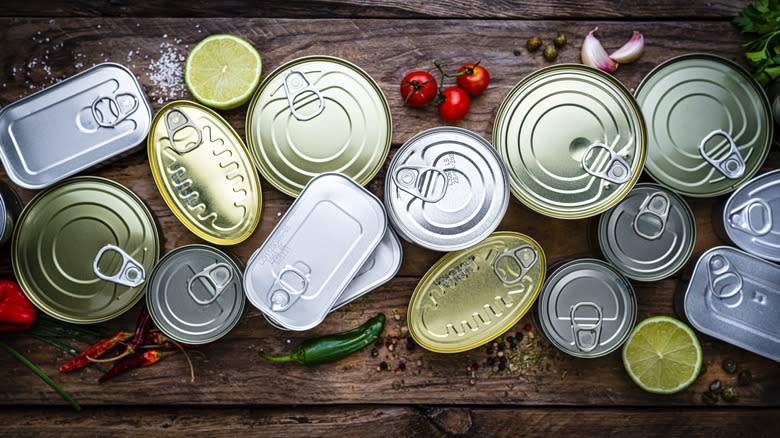
There are many pros to canned foods — they're shelf-stable, cost-efficient, and practical when you want to prep a quick meal. Canned foods in general may get a bad rap, but that's because there are some things to look out for before stocking your pantry with them. Stay away from dented or expired canned foods, for example, as these may be contaminated with bacteria. Stick to BPA-free cans, which are free of the chemical that the International Journal of Molecular Sciences affirms may be linked with cancer and other health issues. It's also a good idea to opt for low or no-sodium canned foods, but sodium is fairly easy to avoid if you're merely buying canned ingredients and not canned meals like soups or pastas.
Of course, canned foods can never replace fresh foods in terms of nutrient concentration and quality; the heating that goes into preserving many canned foods inherently diminishes some of their nutrient content. But depending on what you're looking to whip up in the kitchen or add to your diet, there are a few canned foods that you should definitely be using more often. From providing crazy prep convenience to making up a more diverse pantry, these twelve canned foods will add a new dimension to your cooking.
Read more: 12 Canned Foods You Should Avoid At The Grocery Store
Beets
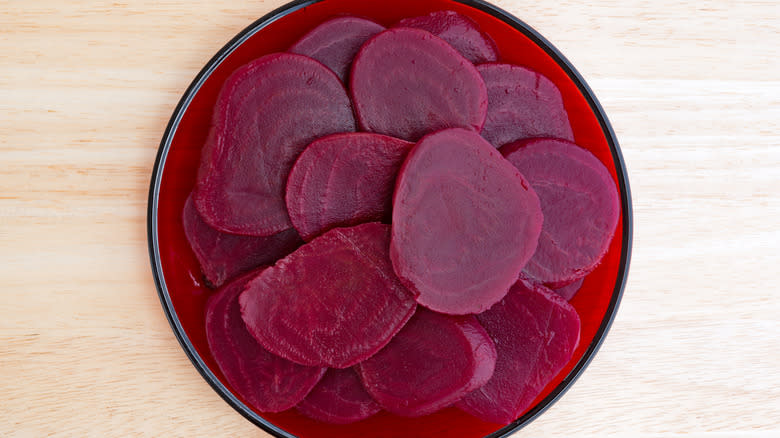
Beets' nutritional benefits alone are a good enough reason to eat more of them. In addition to being a good source of fiber and potassium, they're full of antioxidants, which, according to the Harvard School of Public Health, are a molecular component in certain foods which is known to protect against cancer and heart disease. Despite being more or less at superfood status, one big reason this sweet vegetable hasn't found the same everyday prominence as carrots or peas is simply because beets are a huge hassle to cook.
Not only do beets take a long time to bake or boil, but they are also quick to stain anything they touch. Canned beets, on the other hand, skip the time-consuming process and much of the mess, making for much more stream-lined cooking. Canned beets also generally tend to retain their natural flavor after canning, so they should taste just as good served in salads, soups, or sides. Even the juice from canned beets is useful. Next time you open a can, save your beet juice to use as a vibrant pink food coloring.
Diced Tomatoes
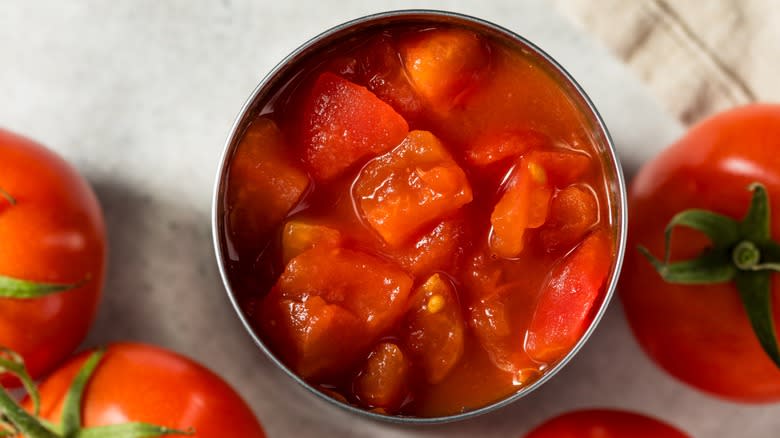
Canned diced tomatoes are a culinary game-changer, not least because they are a formative ingredient in many recipes. From curries to chilis to pasta sauces, there are abundant reasons why they should be stocked on pantry shelves. For example, they're usually more affordable than their fresh counterparts, much quicker to prepare, and available all year long. But in addition to being a kitchen convenience, canned tomatoes have a nutritional advantage over fresh ones.
While many fruits and vegetables tend to lose a bit of nutritional value when they're cooked, tomatoes in some ways benefit from the reverse. One of their most important nutritional components is an antioxidant known as lycopene, which is responsible for tomatoes' red color and has some important health benefits — according to a study in the journal Biomedicine & Pharmacotherapy, it may also be beneficial against carcinogens. Lycopene is more easily absorbable when heated. This can be true for cooking fresh tomatoes, but also applies to the heating that goes into the processing of canned tomatoes, making the latter an unexpectedly nutritious dietary choice in addition to a major culinary convenience.
Heart Of Palm

Heart of palm is exactly that — a vegetable that comes from the core of a palm tree. Harvested in tropical areas, it's not usually consumed fresh, as it doesn't keep very long. More often than not, heart of palm is packaged in cans as a preserved or pickled vegetable, and though it may not be a well-known type of produce, it's a rich source of vegetable protein filled with a plethora of nutrients.
Containing amino acids, calcium, iron, potassium, and Vitamin C among other benefits, heart of palm is as much a health food as a culinary novelty. Whether packed in water or preserved in brine, this vegetable is ready to eat from the can, and has a mild enough flavor that it can be easily added to many dishes. Uncooked in a salad or sautéed in a stir fry, this delicacy is an easy way to add a bit of extra nutrition and diversity to your diet without having to change up favorite recipes. But for those who want a little more inspiration on this vegetable's immense possibilities, here's our beginner's guide.
Sardines
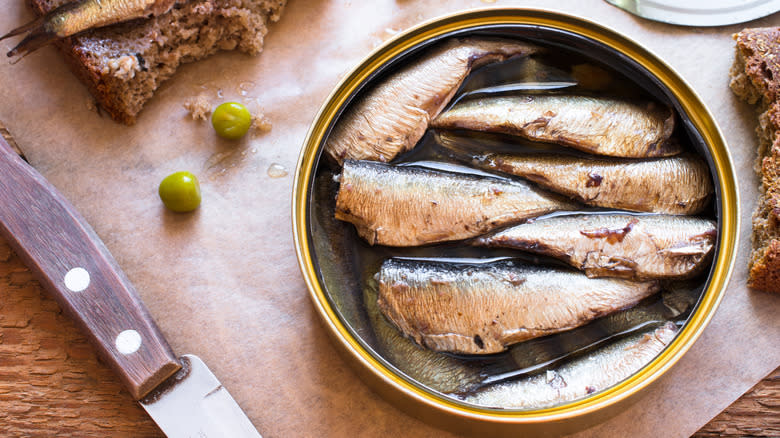
With more Vitamin D per serving than orange juice or standard dairy products, high levels of B12, and even higher levels of Omega 3s, sardines are an underrated superfood. They're also considered among the "best choices" of fish by the FDA, due to their low mercury levels. Though many people may not have the reflex to open up a can of sardines when they're craving a savory snack or looking to assemble a quick meal, sardines are easy to introduce into dishes you already know and love. Add them to salads, starters, or snacks. They're also good cooked up as an accompaniment to dishes like pastas or casseroles. For those who aren't so partial to their taste, a little acid can balance the sardines' fish-forward flavor.
While it may not be as easy to find sardines in any form other than canned, there are some canned varieties that are better than others. Nutritionists recommend choosing sardines that don't have added salt, are in favor of those that have been packed in extra virgin olive oil, and suggest opting for wild-caught sardines when given the option.
Green Chiles
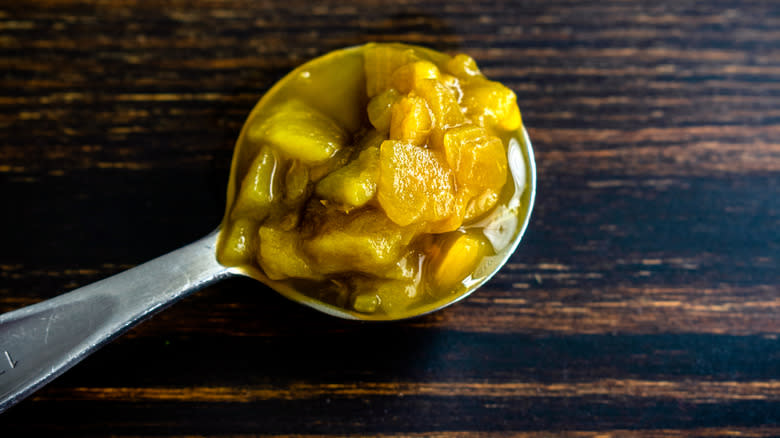
With only a brief growing period between August and September, green chilis are available fresh for such a short time that they're better known to many people as coming from a can. While many may associate green chilis with enchiladas and chili relleno, they add a burst of flavor (and not too much kick) to just about anything you want to spice up. Try adding them to omelets, soups, and mac and cheese for a fresh take on some of the classics. They're also great mixed into sauces, or can be added straight as a garnish.
Besides the flavor kick, green chilis are also a source of vitamin C and capsaicin, a chemical found in chili peppers responsible for their spiciness which is also a powerful antioxidant. The Multidisciplinary Digital Publishing Institute reports that current research suggests capsaicin may fight against cancer and cholesterol, and additionally gives a boost to the metabolism. While a can of green chilis may not be a miracle food in and of itself, some added health benefits are just another reason to keep a can or two on hand.
Coconut Milk

Though most traditionally used in cooking curries, canned coconut milk is a versatile non-dairy milk alternative that can easily replace traditional dairy in many dishes. Harvested from sweet, tender coconut meat, a good can of coconut milk doesn't have a completely liquid texture. Normally, there's a dense layer of cream floating on top of whatever liquid is in the can, which is what has a lot of potential for desserts — like a unique twist to your flan — as well as adding creaminess or thickness to soups, stews, and sauces. While popular in vegan and lactose-free diets, canned coconut milk could be an advantage for anyone because it has a long shelf life, which dairy milks and creams do not.
Many consider coconut milk to be a more healthful alternative to dairy because of its antioxidant and anti-inflammatory effects. While these nutrients in coconut milk may be objectively beneficial, coconut milk also contains very high levels of saturated fats. Not enough research has been conducted to determine if coconut milk's saturated fats are truly the good kind or the bad kind, but either way, it's an adaptable ingredient that will serve pantries well when used occasionally and with moderation.
Olives
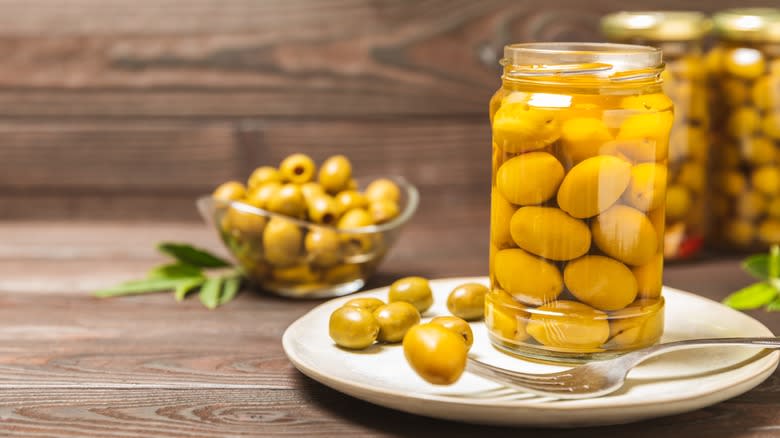
You don't want to find out for yourself what happens if you eat a raw olive, so canned olives may be a no-brainer. Whether they're destined to precede a meal in the form of a martini garnish or the proverbial olive tray, canned olives have a renowned reputation as a delightfully savory appetizer. But they spruce up many main dishes too, especially when added to pasta sauces or meat marinades.
Besides being nifty crowd pleasers, olives are also a clandestine source of Vitamin E, giving them an unexpected dose of antioxidants. Olives are also full of what's known as good cholesterol, which is beneficial for heart health. This savory garnish may not be the first thought as a health supplement, but the nutrient properties of olives are just another reason to enjoy them. No need to overdo it, though, since their salty brine does add up the sodium — Cleveland Clinic recommends no more than a handful a day.
Spinach
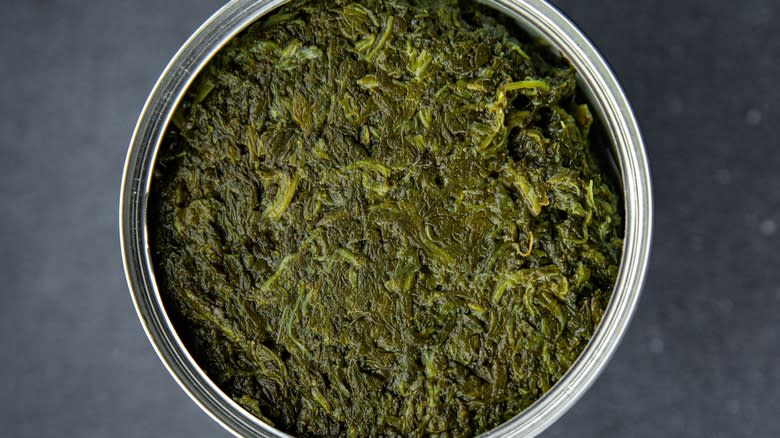
While fresh spinach is more often than not a better choice, it does have a tendency to go bad faster than you can eat it. Canned spinach is one way to solve this problem, and at a lower price point than its fresh counterpart (especially considering how many greens, once condensed, get packed into a single can). There are many reasons to enjoy spinach, since it's a well-known health food as a source of iron, potassium, fiber, vegetable protein, and vitamins, especially vitamins A, K, and C. Though processing canned spinach may degrade some of its nutrient contents, Vitamin C, at least, is something canned spinach retains well. Canned spinach inevitably loses some of its Vitamin C content during the processing that goes into preserving it, but this is a normal reaction of Vitamin C when exposed to heat, and the same thing happens to fresh spinach when cooked.
Fresh produce is also known to lose its vitamin C content after harvest, a phenomenon which continues the longer fresh fruits and vegetables are stored. Canned spinach, on the other hand, retains whichever Vitamin C levels it had after processing which, depending on how long fresh spinach goes uneaten, might mean canned spinach retains more Vitamin C overall than fresh.
Artichoke Hearts
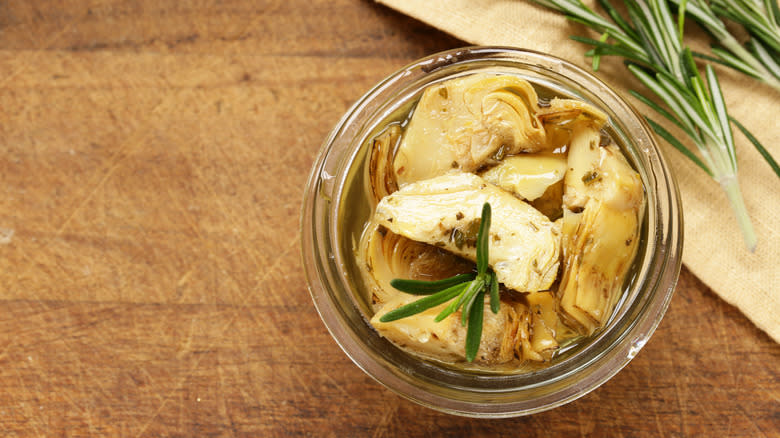
Artichoke hearts are another accouterment full of enough nutrients to merit being a main course. But they're not the easiest vegetable to prepare, and especially not if you're going straight for the heart. Fresh artichokes are prickly, and stripping the outer leaves takes a lot of time. Canned artichokes save many layers of peeling and general prep by getting straight to the good stuff. And even canned, artichoke hearts are a good source of antioxidants, as well as fiber and Vitamin C.
Canned artichoke hearts add a bit of pizzazz to anything looking for a topping, especially if they're marinated. Try adding a gourmet twist to salads, pizzas, pastas, and even sandwiches. You can also find unmarinated canned artichokes, which open up the possibility for more artichoke-centric dishes — they can be baked, roasted, served with meat, blended into homemade hummus, mixed into the iconic artichoke dip, and are even the star ingredient when making a vegan "tuna" salad.
Jackfruit
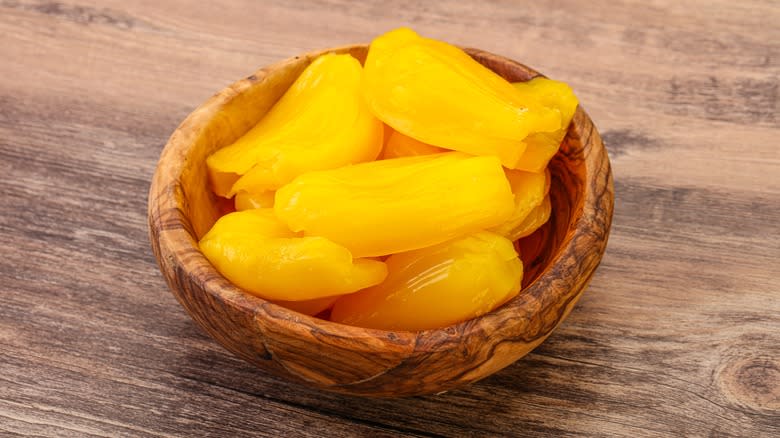
Though a fruit might not be associated with many savory possibilities, jackfruit has taken the world by storm as a plant-based meat alternative. Raw jackfruit has a consistency similar to pulled pork, and its flavor is mild enough that when mixed with the right spices and sauces, it can be difficult to tell the difference between jackfruit and real meat.
If you're planning to use jackfruit as a meat substitute, the raw fruit might not be as easy to find fresh, but it's widely available canned. Peeling and coring a fresh jackfruit and then shredding the flesh certainly takes more time, but the already canned raw "meat" is fairly easy to prepare. Not only is jackfruit a novelty for modern western diets but, per the Institute of Food Technologies, it's full of vitamins, has anti-inflammatory properties, and also may be good for heart health. For all intents and purposes, canned jackfruit can be used to make a fairly healthy but no less delicious substitute for beef tacos, pulled pork sandwiches, or any other dish centered around ground or shredded meat.
Pumpkin
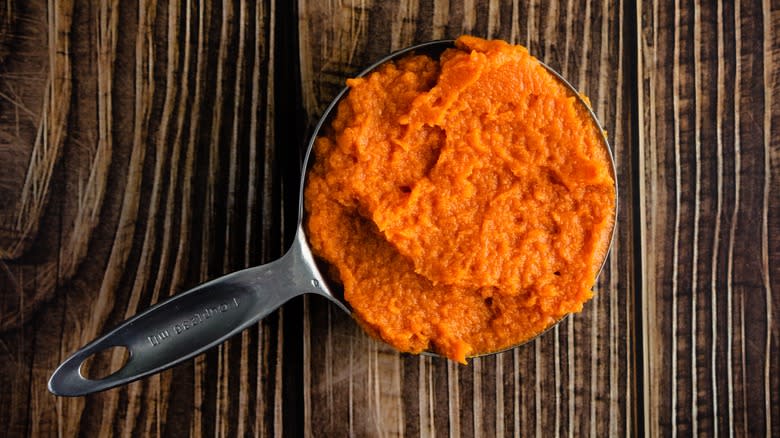
Full of vitamins, fiber, potassium, and antioxidants, while being good for digestion, blood sugar, and cholesterol, pumpkin is a vegetable worth eating more often, and canned pumpkin is even more nutritious than fresh. But nutrients aside, pumpkin is one vegetable which indisputably makes more sense to buy from a can. This is because prepping a fresh pumpkin to achieve the same texture as ready-to-cook canned pumpkin requires the difficulty of peeling, and many hours of baking and re-baking before it's ready to add to a recipe. While canned pumpkin might not be as prevalent outside of the pumpkin spice season, it is, at least, available year-round when fresh pumpkin only surfaces in the fall. Canned pumpkin is an overall much simpler choice, whether used for sweet or savory dishes.
Besides the automatic convenience of pre-preparation, canned pumpkin is also something worth keeping on hand for more than just nutrition-oriented meals or fall-themed recipes. Canned pumpkin adds moisture to baked goods, and works as a substitute for butter or oil, allowing for recipes that are low fat but still have a quality texture. Canned pumpkin can also function as a binder to replace egg or gluten in vegan or gluten-free baking. What's more, though it naturally pairs very well with all things sweet, canned pumpkin is also an underused vegetable for savory dishes, adding a creamy texture to soups, curries, and pasta sauces.
Chickpeas
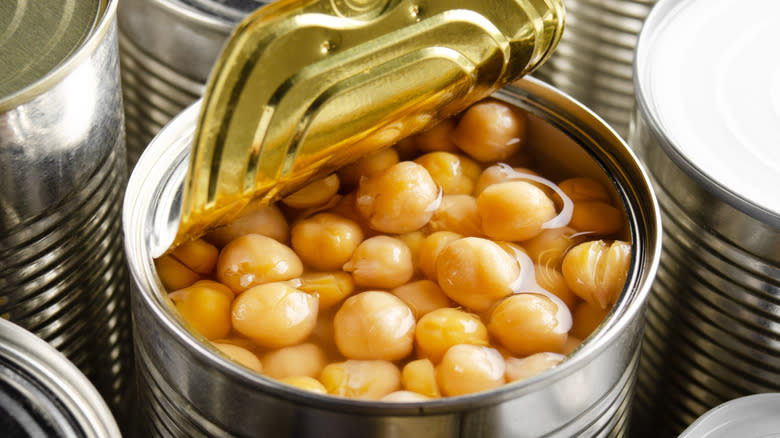
A good source of fiber and protein, chickpeas are a worthy addition to any diet if you don't eat them already. Excellent in soup, stews, and curries, they have an adaptable texture which also makes them good for blending into a hummus spread. Though chickpeas are certainly more cost-effective when bought dry and in bulk, cooking them this way from scratch is a very time-consuming process. If they're to be prepared properly, dry chickpeas require hours of soaking and a long time simmering in a pot before they're ready to prepare in any given recipe, and even then it's sometimes hard to cook them into just the right texture. Canned chickpeas skip these steps, allowing for a little more spontaneity. Though purists may claim that canned chickpeas' flavor isn't quite the same, there also isn't much of a difference if said chickpeas are added to savory soups or flavorful sauces.
Not only can canned chickpeas get whipped up into a meal within minutes, but the liquid that accompanies them in a can is worth holding onto as well. Known as aquafaba, this is a starchy, syrupy substance invaluable to alternative baking that you can't get from any other can of beans. This unassuming leftover liquid adds texture and structure to vegan and gluten-free baked goods. With its binding properties, aquafaba can replace eggs in most baking, and when whipped, it metamorphosizes just like egg whites into a thick meringue froth — not too shabby for a novelty byproduct.
Read the original article on Daily Meal

